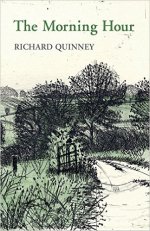 The Morning Hour
The Morning Hour
by Richard Quinney
Born in 1934 in Elkhorn, Wisconsin, Richard Quinney has been a Sociology professor, photographer, Delegate of Crime Prevention for the Eisenhower Foundation, husband, father, Buddhist meditation practitioner, and author of more than a dozen books about Sociology, nature, and photography. Perhaps it is no wonder, then, that his latest work, The Morning Hour, which comprises a series of reflections on his personal life, covers such a wide range of topics.
 In the preface to his book, Quinney reveals the origin of its title. Every day for decades, the morning hours have been his time “for contemplation and of the writing a few words to the day.” He fills his journals with thoughts about things he finds most interesting and dear: family, work, the beauty of the natural world, what it means to die. Now in his eighties, Quinney has completed more than fifty years’ worth of journal entries. The Morning Hour contains a selection of these writings, organized thematically, each one no more than a couple pages long. Despite their brevity, the reflections are impressively erudite, evidence of a curious mind that has devoured a lifetime’s worth of literature, from Homer’s epics to The Great Gatsby to the Tibetan Book of the Dead. From these books he’s derived questions—and a few answers—about what it means to live mindfully and with intention.
In the preface to his book, Quinney reveals the origin of its title. Every day for decades, the morning hours have been his time “for contemplation and of the writing a few words to the day.” He fills his journals with thoughts about things he finds most interesting and dear: family, work, the beauty of the natural world, what it means to die. Now in his eighties, Quinney has completed more than fifty years’ worth of journal entries. The Morning Hour contains a selection of these writings, organized thematically, each one no more than a couple pages long. Despite their brevity, the reflections are impressively erudite, evidence of a curious mind that has devoured a lifetime’s worth of literature, from Homer’s epics to The Great Gatsby to the Tibetan Book of the Dead. From these books he’s derived questions—and a few answers—about what it means to live mindfully and with intention.
His reflections are perhaps most insightful when he connects his existential musings to smaller, more personal moments. In one particularly moving passage, Quinney describes his experience of standing in front of Georges-Pierre Seurat’s painting Sunday Afternoon on the Island of La Grande Jatte at the Art Institute of Chicago, squinting so “the dots of paint make new colors.” His mind drifts to thoughts of his daughter, who lives in Paris, and what it means to be her father and a grandfather to her children. The passage is both touching and provocative, a lovely reminder that great art is more than the sum of its formal aesthetics: When considered thoughtfully, it can evoke some of life’s most important insights.

Author Richard Quinney
The book also shares the author’s insights into death. When he was a child, writes Quinney, his religious mother made him recite the Lord’s Prayer every evening before bed, the last two lines, he reminds us, centered on dying: “If I should die before I wake/I pray the Lord my soul to take.” For most of his adult life, Quinney did not recite the prayer. But now in old age, he finds himself thinking of it often. As depressing as this preoccupation with dying may sound, Quinney’s view of death, we learn, is informed by The Diamond Sutra and other Buddhist writings, which describe the process of dying not as an end to life but as the ongoing, natural state of all living things. Here he illustrates the Buddhist concept of death by comparing it to the act of looking at photographs:
There is a difference between the portrait of the ancestor living at the instant of the photograph and my viewing of the portrait after the ancestor has passed away. […] And there is the realization that there is a fine line, and only a fine line, between those who once lived and those of us who live today. The separation between the living and the dead vanishes readily with time. The vastness of our time of being unborn makes our living, our existing, but a drop of dew, a flash of lightning, and a dream. Unborn is our primary natural state.
The book’s frequent focus on death does not detract from its uplifting messages about living well. When considering life beyond family, the book brims with images of blooming gardens, birds in flight, and majestic mammals, which together form a vital and animated view of the natural world. The juxtaposition of bountiful life with death is striking but important, it seems, to Quinney’s overarching philosophy. By insisting that life and death are worth pondering in equal measure, Quinney creates a vision of existence that enlightens and comforts—impermanence, he seems to say, is a part of being human, and in our impermanence, we become both precious and beautiful.

April 2016, Borderland Books/University of Wisconsin Press
Nonfiction/Mindfulness & Meditation
$24, hardcover, 176 pages
ISBN: 978-0-9965052-1-5
—Reviewed by Amy Brady

fyi, the last two lines of the Lord’s Prayer (aka Our Father) are NOT “if I die before I wake” etc. Those lines, rather, are from the children’s prayer that begins, “Now I lay me down to sleep.”
LikeLike